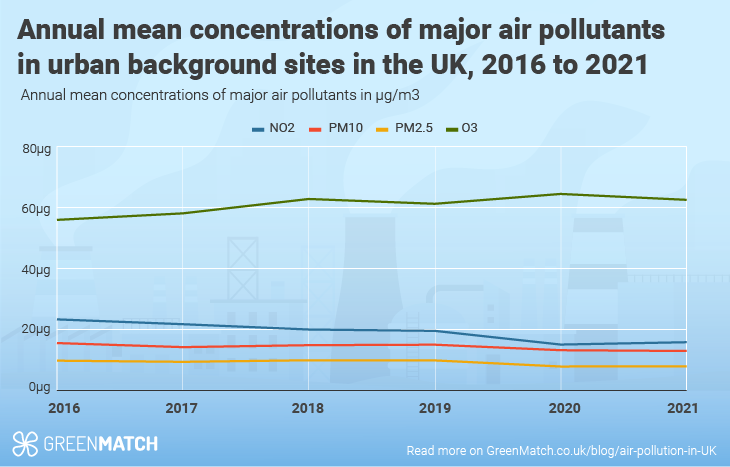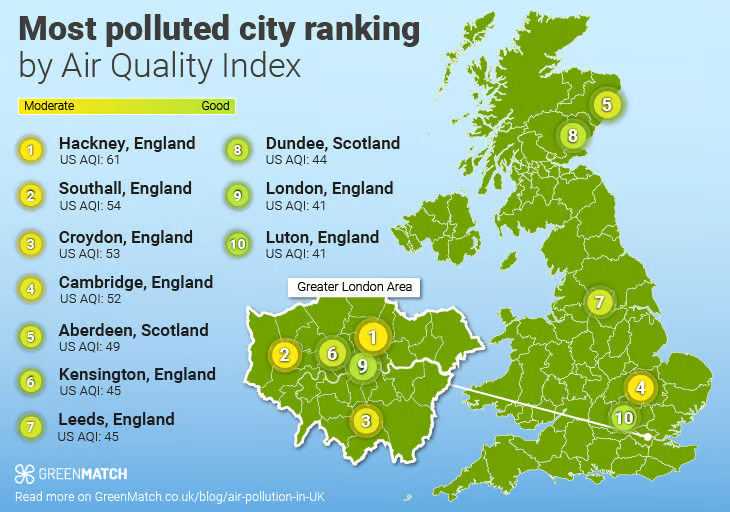- GreenMatch
- Blog
- Air Pollution in the UK
Air Pollution in the UK: Progress and Challenges

Did you know that 99% of the world's population lives in places where air pollution levels exceed the guidelines set by the World Health Organisation? From urban smog to indoor smoke, air pollution poses a significant global health threat, increasing the risk of heart disease, stroke, cancer, and pneumonia for nearly everyone.
In the UK, poor air quality is recognised as "the largest environmental risk to public health." However, the impacts of poor air quality extend far beyond our well-being, affecting our natural environment, economy, and the trajectory of climate change.
To combat this, the UK Government has made substantial efforts to reduce the presence of the most harmful air pollutants. These pollutants can be traced back to various aspects of our daily lives and industries, prompting several government initiatives to decarbonise these key sectors.
Although some progress has been achieved on legislative, industrial, and societal fronts, it's clear that further action is needed to mitigate the most severe consequences of air pollution in the UK.
Legislation and Regulations
Strategies to tackle air pollution in the UK are directed from various international and EU legislative measures and more national efforts. Some of the most prominent measures implemented in the UK include:
The Gothenburg Protocol
This international agreement sets emissions ceilings for numerous pollutants such as sulphur dioxide, nitrogen oxide, and ammonia. This aims to control long-range pollution across countries.
EU Air Quality Directive
This EU-wide measure has been implemented across the UK through set regulations for England, Scotland, Wales and Northern Ireland. This sets parameter concentrations of pollutants that must not be exceeded, including nitrogen dioxide and particulate matter.
The Environment Act
The Environment Act 1995 obligated the UK Government and individual devolved governments to enforce an air quality strategy. In Northern Ireland, this obligation instead falls under the Environment Order 2002. Each government also has its own environmental governance body.
More recently, the Environment Act 2021 obligated the UK Government to set some legally binding environmental targets. These were proposed in 2022 to look something like:
Clean Air Act
This bill would establish the right to breathe clean air by reducing pollution in our indoor and outdoor spaces and from vehicles and setting minimum standards for air quality in the workplace, the home, and public spaces.
Through this bill, the Secretary of State would also be required to promote public awareness of the impact of air pollution on public health. This bill is making its way through the parliament and is still some way away from being finalised.
Key Air Pollutants
Key air pollutants of concern in the UK are:
To monitor the threat of these pollutants, the UK Government found the annual national average concentrations of some of these pollutants, as shown below.

Compared to the World Health Organisation air quality guidelines, annual levels of PM2.5 and NO2 in the UK sit nearly 60% higher than recommended levels. PM10 falls below the recommended levels by 15% in urban background sites, not considering roadside pollution or rural background sites.
Highlights from the government's findings
Nitrogen Dioxide (NO2)
Over the years, cities' average yearly NO2 pollution levels have decreased. In 2021, the concentration of NO2 was 15.8 µg/m3, which was a 5% increase from 2020 but still the lowest since 1990.
In 2020, NO2 levels dropped by 23%, likely due to COVID-19 restrictions reducing traffic. Between 1997 and 2021, an average yearly decline was 1.3%.
Particulate Matter (PM10/PM2.5)
The yearly average concentrations of PM10 in urban areas have decreased from 36.1 µg/m3 in 1992 to 12.9 µg/m3 in 2021, the lowest ever recorded.
For PM2.5, concentrations dropped from 12.4 µg/m3 in 2009 to 7.9 µg/m3 in 2021. Notably, there was a significant 20% decrease from 2019 to 2020, but in 2021, concentrations went up by 0.6%, which wasn't statistically significant.
Ozone (O₃)
In 2021, there was a 3% decrease in ozone levels compared to 2020, with the highest levels in the recorded data.
With that being said, the highest ozone concentrations in UK cities have all been observed in the previous 3 years (2018, 2019, and 2020).
Sources of Air Pollution
Air pollution in the UK has a broad spectrum of sources, from industrial activities like manufacturing and energy production to the everyday actions of individuals in their cars and homes.
Transportation
Transport represents the main source of air pollution in urban areas in the UK. Nitrogen oxides and particulate matter are the most significant air pollutants from transport, especially road traffic. Diesel engines in particular, release much more pollutants than gasoline-fuelled vehicles.
In fact, in 2020, transport accounted for one-third of the UK's nitrogen oxides, 14% of PM2.5, and 12% of PM10 air pollution.
Air pollution from transport has steadily decreased over the last few decades thanks to newer vehicles emitting fewer harmful pollutants. While this is the case for most vehicle types, vans have seen a 5,000-tonne increase in emissions compared to 2010.
Industrial activities
Emissions from industrial sites, including manufacturing and energy generation, are a major contributor to particulate matter emissions, contributing 26% of PM2.5 and 16% of PM10 emissions in 2021.
Other common air pollutants from industrial activity in the UK include nitrogen oxides, nitrogen dioxide, sulphur dioxide, and cadmium.
The primary source of these pollutants is the combustion of fossil fuels during manufacturing and production processes. Biomass fuel combustion in industry has also increased over the years, contributing 19% of total PM2.5 emissions in 2020, up from 6% in 2013.
Domestic heating
Some of the major air pollutants that come from domestic heating include particulate matter, nitrogen oxides (NOx), ammonia, sulphur dioxide (SOx), carbon monoxide (CO), and methane.
These pollutants are released from burning fossil fuels and biomass for heating and energy in homes. This is the largest proportion of toxic carbon monoxide emissions (CO). Not only can high concentrations of CO cause death in humans, but it also contributes to the formation of ground-level ozone, causing more air pollution problems.
As seen with industrial emissions, using biomass fuels for residential heating and energy has also increased total emissions, particularly of CO and PM2.5. Meanwhile, coal-fuelled heating is the biggest contributor of CO, NOx, PM2.5, and SOx emissions. Whereas gas-fuelled heating is associated most prominently with NOx emissions.
Agriculture
While urban areas have the highest concentrations of pollutants associated with road transport and heating, rural areas contribute significant pollution thanks to agricultural processes.
Ammonia (NH3), particulate matter (PM10), and nitric oxide (NOx) are all released into the air from fumes from nitrogen-rich fertilisers and animal waste, particularly from cattle. Secondary pollutants, such as particulate matter and ozone, are also created when ammonia reacts with nitrogen oxides and sulphur dioxide in the air.
Agriculture is the largest contributor of ammonia and nitrous oxide in the UK, contributing 87% and 69%, respectively, in 2020. Livestock is also a major source of methane emissions, contributing 48% in 2020.
Long-term reductions in cattle numbers and more efficient use of fertilisers have caused ammonia emissions from agriculture to fall 10% in 2021 compared to 2005.
Air Quality Challenges
There have been many measures that have reduced air pollution in the UK, particularly from road vehicles. Despite this progress, concentrations of the most harmful pollutants remained above the World Health Organisation's (WHO) recommended levels in all of the UK capitals in 2022.
The recommended yearly average nitrogen dioxide concentrations in the UK were four times as much as those recommended by WHO. The average PM2.5 concentration in the UK was 1.8 times the WHO annual air quality guideline value, according to research by the Centre for Research on Energy and Clean Air.

Almost every home in the UK is subjected to air pollution above guidelines set by WHO, with over 97% of homes exceeding WHO limits for at least 1 of 3 key pollutants.
Health Impacts
Air pollution can impact people's health in many ways- from your eyes, nose and throat to your heart and associated blood vessels to your lungs and respiratory system.
The exceeded levels of air pollutants beyond WHO's guidelines have been directly linked with 250,000 NO2-related deaths and 70,000 cases of asthma in children by the Centre for Research on Energy and Clean Air.
Air pollution can affect anyone at any stage of life. However, children, the elderly, and individuals with pre-existing health conditions tend to be most at risk of detrimental health impacts.
Air pollution can cause various ailments, including coughing, shortness of breath, and asthma exacerbation after just a few hours. Longer-term exposure to air pollution can cause life-threatening cardiovascular and respiratory diseases and lung cancer.
It has also been linked with dementia and cognitive decline, low birth weight, and developmental problems in newborns.
Government Initiatives
Government initiatives to address air pollution and promote environmental sustainability encompass a range of strategies, from establishing low-emission zones to encourage cleaner transportation to incentives and discounts for electric vehicle adoption, stringent emission standards for industries, and support for domestic renewable energy systems.
Low-emission zones
In certain areas of the UK, the government has introduced road user charging zones such as London’s low emission zone (LEZ) and ultra-low emission zone (ULEZ), England’s clean air zones (CAZ), and Scotland’s low emission zones (LEZ).
These are intended to reduce air pollution by charging those with more polluting vehicles upon entry into these zones. Some areas include Bath, Birmingham, and Bradford, where non-compliant vehicles are charged upon entry. In Scotland, LEZ schemes dictate that non-compliant vehicles must not enter at any time.
Emissions-free transport
Another important area of government action towards reducing air pollution is the promotion of electric vehicles through incentives and discounts for EV car owners or prospective buyers.
Some examples of these schemes include discounts of up to 35% off the purchase price of a new EV, up to a maximum of £2,500 through the Plug In Car Grant; Interest-Free Vehicle Loans in Scotland and Northern Ireland; and tax exemptions from the Vehicle Excise Duty and Premium rate tax.
Green number plate holders can also take advantage of free parking and use bus lanes or drive-through areas restricted for conventional vehicles.
The government also proposed a ban on the sale of new petrol and diesel cars, which will run from 2035, previously set to run from 2030. This means that only fully electric cars will be available to buy new.
Emission standards for the industry
The UK Government aims to bring the most relevant and effective emission reduction standards across the UK's largest industries through the Best Available Techniques framework.
This involves setting emissions limits within environmental permits and identifying the most effective technologies and methods available to meet these limits.
Domestic renewable energy incentives
The government has also introduced various schemes to increase the uptake of domestic renewable energy systems. This includes grants towards low-carbon heating systems such as the Boiler Upgrade Scheme and the Energy Company Obligation, which obligates larger energy suppliers to deliver energy efficiency measures to eligible homes.
Public Awareness
The threats of air pollution must remain at the forefront of public consciousness, not only so people have an awareness of risks to their health but also of the impact their actions might be contributing to the problem of air pollution.
Effective air pollution public awareness can bring meaningful change in key areas, such as deciding to travel using public transport or cycling and choosing renewable energy solutions for your home heating and power.
An important example of worldwide awareness spreading is the International Day of Clean Air for Blue Skies, an annual commemoration of the importance of clean air for people's health everywhere.
Public awareness of the effects of air pollution can be most effectively raised on a local level. Local authorities can provide educational initiatives and localised data that allow people to see the problems caused by air pollution and how they can amend their actions towards cleaner air for their community.
Future Outlook
As is the case with so many environmental issues, climate change will continue to exacerbate the problem of air pollution in the coming decades. Increased wildfires emit huge amounts of pollutants into the air, and changing weather patterns risk bringing polluted air to the UK worldwide.
Improving air quality in the UK means drastically decarbonising our transport, energy production, and industries. Doing so will bring immediate benefits to those worse affected by air pollution.
Research commissioned by the Clean Air Fund found that the UK could bring levels of PM2.5 down to 10µg m3 across the UK by 2030, which would fall into WHO 'interim target' guidelines. Pursuing the reduction of PM2.5 helps to reduce harmful PM10 and nitrogen dioxide emissions.
This is possible provided current and proposed government policies are fully implemented, including those outlined in the Clean Air Strategy and the Environment Bill.
The report finds that setting these levels as a legally binding target would significantly benefit the health of the UK population by reducing asthma symptom days and incidences of heart disease and increasing the average life expectancy from birth.
Please note that the air quality can change over time due to various factors, including government policies, technological advancements, and economic developments. To get the most current information on air pollution in the UK, consult the latest reports and data from authoritative sources such as the UK Government's Department for Environment, Food & Rural Affairs (DEFRA) and the World Air Quality Index (WAQI).

Ciaran is a content writer at GreenMatch. Whether writing about sustainable aviation fuel or heat pumps, Ciaran has passion for informing readers about pivotal technologies that are reshaping our world.
We strive to connect our customers with the right product and supplier. Would you like to be part of GreenMatch?

